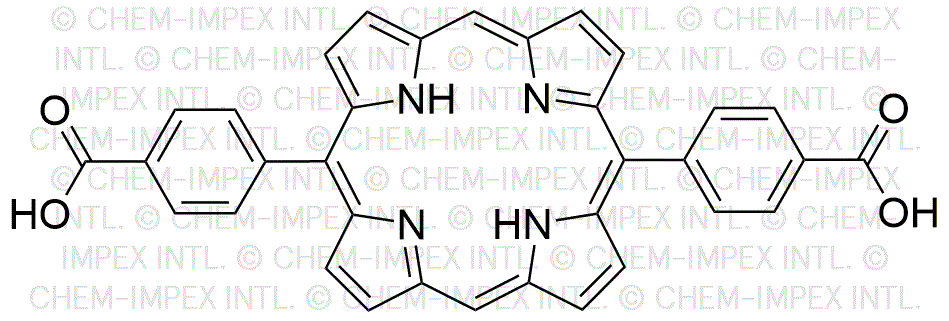5,15-(di-4-Carboxyphenyl)porphyrin is widely utilized in research focused on:
- Photodynamic Therapy (PDT): This compound is effective in treating certain types of cancer by generating reactive oxygen species when exposed to light, helping to destroy cancer cells while minimizing damage to surrounding healthy tissue.
- Solar Energy Conversion: Its unique structure allows it to be used in dye-sensitized solar cells, improving the efficiency of converting sunlight into electricity, which is crucial for renewable energy applications.
- Biochemical Sensors: The compound can be employed in the development of sensors for detecting specific biomolecules, enhancing diagnostic capabilities in medical and environmental fields.
- Drug Delivery Systems: Its ability to form stable complexes with various drugs makes it a valuable component in targeted drug delivery, ensuring that medications are released at the right site in the body.
- Research in Catalysis: This porphyrin derivative can serve as a catalyst in various chemical reactions, offering advantages in reaction rates and selectivity compared to traditional catalysts.
General Information
Properties
Safety and Regulations
Applications
5,15-(di-4-Carboxyphenyl)porphyrin is widely utilized in research focused on:
- Photodynamic Therapy (PDT): This compound is effective in treating certain types of cancer by generating reactive oxygen species when exposed to light, helping to destroy cancer cells while minimizing damage to surrounding healthy tissue.
- Solar Energy Conversion: Its unique structure allows it to be used in dye-sensitized solar cells, improving the efficiency of converting sunlight into electricity, which is crucial for renewable energy applications.
- Biochemical Sensors: The compound can be employed in the development of sensors for detecting specific biomolecules, enhancing diagnostic capabilities in medical and environmental fields.
- Drug Delivery Systems: Its ability to form stable complexes with various drugs makes it a valuable component in targeted drug delivery, ensuring that medications are released at the right site in the body.
- Research in Catalysis: This porphyrin derivative can serve as a catalyst in various chemical reactions, offering advantages in reaction rates and selectivity compared to traditional catalysts.
Documents
Safety Data Sheets (SDS)
The SDS provides comprehensive safety information on handling, storage, and disposal of the product.
Product Specification (PS)
The PS provides a comprehensive breakdown of the product’s properties, including chemical composition, physical state, purity, and storage requirements. It also details acceptable quality ranges and the product's intended applications.
Certificates of Analysis (COA)
Search for Certificates of Analysis (COA) by entering the products Lot Number. Lot and Batch Numbers can be found on a product’s label following the words ‘Lot’ or ‘Batch’.
Numéro de catalogue
Numéro de lot/série
Certificates Of Origin (COO)
This COO confirms the country where the product was manufactured, and also details the materials and components used in it and whether it is derived from natural, synthetic, or other specific sources. This certificate may be required for customs, trade, and regulatory compliance.
Numéro de catalogue
Numéro de lot/série
Safety Data Sheets (SDS)
The SDS provides comprehensive safety information on handling, storage, and disposal of the product.
DownloadProduct Specification (PS)
The PS provides a comprehensive breakdown of the product’s properties, including chemical composition, physical state, purity, and storage requirements. It also details acceptable quality ranges and the product's intended applications.
DownloadCertificates of Analysis (COA)
Search for Certificates of Analysis (COA) by entering the products Lot Number. Lot and Batch Numbers can be found on a product’s label following the words ‘Lot’ or ‘Batch’.
Numéro de catalogue
Numéro de lot/série
Certificates Of Origin (COO)
This COO confirms the country where the product was manufactured, and also details the materials and components used in it and whether it is derived from natural, synthetic, or other specific sources. This certificate may be required for customs, trade, and regulatory compliance.

